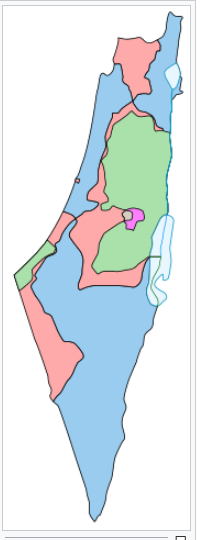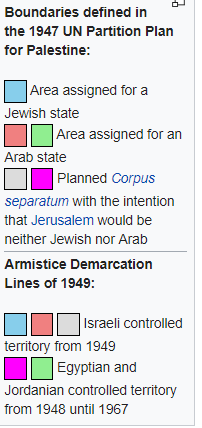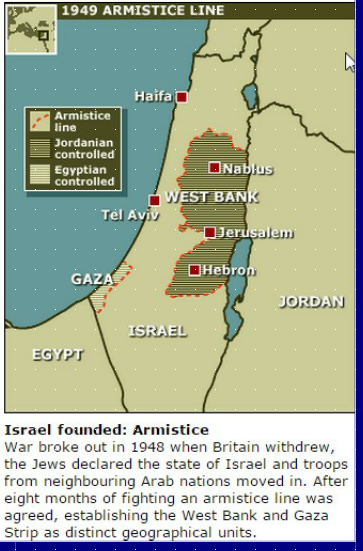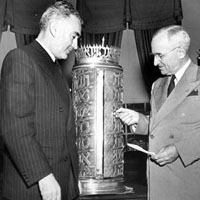|
PART 1 T O P I C |
|
|
|
|
|
|
|
|
|
|
|
|
|
|
|
|
|
|
JewishWikipedia.info
|
|
|
|
|
CLICK BUTTON |
|
|
|
|
|
|
|
|
|
Israel |
|
|
|
|
|
|
|
ISRAEL - PALESTINIAN |
|
|
|
|
|
|
THE
INCREDIBLE
STORY OF THE JEWISH PEOPLE
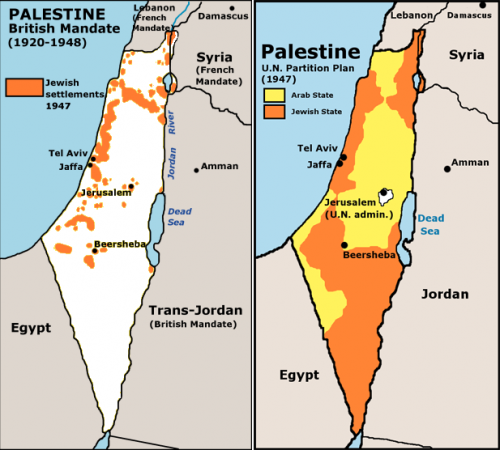
The result was as follows following intense lobbying by the Jewish and Arab sides.
FOR THE RESOLUTION (33) - Australia, Belgium, Bolivia, Brazil, Canada, Costa Rica, Czechoslovakia, Denmark, Dominican Republic, Ecuador, France, Guatemala, Haiti, Iceland, Liberia, Luxembourg, the Netherlands, New Zealand, Nicaragua, Norway, Panama, Paraguay, Peru Philippines, Poland, Sweden, Ukraine, South Africa, Uruguay, the Soviet Union, the United States, Venezuela, White Russia.
AGAINST (13) - Afghanistan, Cuba, Egypt, Greece, India, Iran, Iraq, Lebanon, Pakistan, Saudi Arabia, Syria, Turkey, Yemen.
ABSTENTIONS (10) - Argentina, Chile, China, Colombia, El Salvador, Ethiopia, Honduras, Mexico, United Kingdom, Yugoslavia.
ABSENT (1) - Siam.
THE UNITED NATIONS PARTITION PLAN FOR PALESTINE
Wikipedia
The United Nations Partition Plan for Palestine was a proposal by the United Nations, which recommended a partition of Mandatory Palestine at the end of the British Mandate. On 29 November 1947, the U.N. General Assembly adopted the Plan as Resolution 181
The resolution recommended the creation of independent Arab and Jewish States and a Special International Regime for the city of Jerusalem. The Partition Plan, a four-part document attached to the resolution, provided for the termination of the Mandate, the progressive withdrawal of British armed forces and the delineation of boundaries between the two States and Jerusalem. Part I of the Plan stipulated that the Mandate would be terminated as soon as possible and the United Kingdom would withdraw no later than 1 August 1948. The new states would come into existence two months after the withdrawal, but no later than 1 October 1948. The Plan sought to address the conflicting objectives and claims of two competing movements, Palestinian nationalism and Jewish nationalism, or Zionism. The Plan also called for Economic Union between the proposed states, and for the protection of religious and minority rights.
The Plan was accepted by the Jewish Agency for Palestine, despite its perceived limitations. Arab leaders and governments rejected it and indicated an unwillingness to accept any form of territorial division, arguing that it violated the principles of national self-determination in the UN charter which granted people the right to decide their own destiny.
Immediately after adoption of the Resolution by the General Assembly, a civil war broke out and the plan was not implemented.
UNITED NATIONS RESOLUTION 181 - PARTITION OF PALESTINE INTO ARAB AND JEWISH STATES
Encyclopedia Britanica
United Nations Resolution 181, resolution passed by the United Nations (UN) General Assembly in 1947 that called for the partition of Palestine into Arab and Jewish states, with the city of Jerusalem as a corpus separatum (Latin: “separate entity”) to be governed by a special international regime. The resolution—which was considered by the Jewish community in Palestine to be a legal basis for the establishment of Israel, and which was rejected by the Arab community—was succeeded almost immediately by violence.
Palestine had been governed by Great Britain since 1922. Since that time, Jewish immigration to the region had increased, and tensions between Arabs and Jews had grown. In April 1947, exhausted by World War II and increasingly intent upon withdrawing from the Middle East region, Britain referred the issue of Palestine to the UN. To investigate a suitable course of action, the UN formed the UN Special Committee on Palestine (UNSCOP), an inquiry committee made up of members from 11 countries. Ultimately, UNSCOP delivered two proposals: that of the majority, which recommended two separate states joined economically, and that of the minority, which supported the formation of a single binational state made up of autonomous Jewish and Palestinian areas. The Jewish community approved of the first of these proposals, while the Arabs opposed them both and instead suggested a single secular democratic state in Palestine with citizens receiving equal rights. A counterproposal—including a provision that only those Jews who had arrived before the Balfour Declaration (and their descendents) would be citizens of the state—did not win Jewish favour.
The proposal to partition Palestine, based on a modified version of the UNSCOP majority report, was put to a General Assembly vote on Nov. 29, 1947. The fate of the proposal was initially uncertain, but after a period of intense lobbying by pro-Jewish groups and individuals, the resolution was passed with 33 votes in favour, 13 against, and 10 abstentions.
UN RESOLUTION 181 – THE (PALESTINE) PARTITION PLAN
Mythsandfacts,, Eli E. Hertz
(go to link for full analysis)
In 1947 the British put the future of western Palestine into the hands of the United Nations, the successor organization to the League of Nations which had established the Mandate for Palestine. A UN Commission recommended partitioning what was left of the original Mandate – western Palestine – into two new states, one Jewish and one Arab. [1] Jerusalem and its surrounding villages were to be temporarily classified as an international zone belonging to neither polity.
What resulted was Resolution 181 [known also as the 1947 Partition Plan], a non-binding recommendation to partition Palestine, whose implementation hinged on acceptance by both parties – Arabs and Jews. The resolution was adopted on November 29, 1947 in the General Assembly by a vote of 33-12, with 10 abstentions. Among the supporters were the United States and the Soviet Union, as well as other nations including France and Australia. The Arab nations, including Egypt, Syria, Iraq, and Saudi Arabia denounced the plan on the General Assembly floor and voted as a bloc against Resolution 181 promising to defy its implementation by force.
The resolution recognized the need for immediate Jewish statehood (and a parallel Arab state), but the blueprint for peace became a moot issue when the Arabs refused to accept it. Subsequently, de facto [In Latin: realities] on the ground in the wake of Arab aggression (and Israel’s survival) became the basis for UN efforts to bring peace.
Aware of Arabs’ past aggression, Resolution 181, in paragraph C, calls on the Security Council to:
“Determine as a threat to the peace, breach of the peace or act of aggression, in accordance with Article 39 of the Charter, any attempt to alter by force the settlement envisaged by this resolution.” [italics by author]
The ones who sought to alter the settlement envisioned in Resolution 181 by force, were the Arabs who threatened bloodshed if the United Nations was to adopt the Resolution:
“The [British] Government of Palestine fear that strife in Palestine will be greatly intensified when the Mandate is terminated, and that the international status of the United Nations Commission will mean little or nothing to the Arabs in Palestine, to whom the killing of Jews now transcends all other considerations. Thus, the Commission will be faced with the problem of how to avert certain bloodshed on a very much wider scale than prevails at present. … The Arabs have made it quite clear and have told the Palestine government that they do not propose to co-operate or to assist the Commission, and that, far from it, they propose to attack and impede its work in every possible way. We have no reason to suppose that they do not mean what they say.” [2] [italics by author]
Arabs’ intentions and deeds did not fare better after Resolution 181 was adopted:
“Taking into consideration that the Provisional Government of Israel has indicated its acceptance in principle of a prolongation of the truce in Palestine; that the States members of the Arab League have rejected successive appeals of the United Nations Mediator, and of the Security Council in its resolution 53 (1948) of 7 July 1948, for the prolongation of the truce in Palestine; and that there has consequently developed a renewal of hostilities in Palestine." [3]
The conclusion:
“Having constituted a Special Committee and instructed it to investigate all questions and issues relevant to the problem of Palestine, and to prepare proposals for the solution of the problem, and having received and examined the report of the Special Committee (document A/364). … Recommends to the United Kingdom, as the mandatory Power for Palestine, and to all other Members of the United Nations the adoption and implementation, with regard to the future Government of Palestine, of the Plan of Partition with Economic Union set out below;” [italics by author].
In the late 1990s, more than 50 years after Resolution 181 was rejected by the Arab world, Arab leaders suddenly recommended to the General Assembly that UN Resolution 181 be resurrected as the basis for a peace agreement. There is no foundation for such a notion.
Resolution 181 was the last of a series of recommendations that had been drawn up over the years by the Mandator and by international commissions, plans designed to reach an historic compromise between Arabs and Jews in western Palestine. The first was in 1922 when Great Britain unilaterally partitioned Palestine, which did not satisfy the Arabs who wanted the entire country to be Arab. Resolution 181 followed such proposals as the Peel Commission (1937); the Woodhead Commission (1938); two 1946 proposals that championed a bi-national state; one proposed by the Anglo-American Committee of Inquiry in April 1946 based on a single state with equal powers for Jews and Arabs; and the Morrison-Grady Plan raised in July 1946 which recommended a federal state with two provinces – one Jewish, one Arab. Every scheme since 1922 was rejected by the Arab side, including decidedly pro-Arab ones merely because these plans recognized Jews as a nation and gave Jewish citizens of Mandate Palestine political representation.
CREATION OF ISRAEL, 1948
Office of the US Historian
On May 14, 1948, David Ben-Gurion, the head of the Jewish Agency, proclaimed the establishment of the State of Israel. U.S. President Harry S. Truman recognized the new nation on the same day.
Eliahu Elath presenting an ark containing the Torah
to President Truman
(The Torah is Judaism’s most important text. It is composed of the Five Books of Moses, the 613 commandments (mitzvot) and the Ten Commandments.)
The word “Torah” means “to teach.”
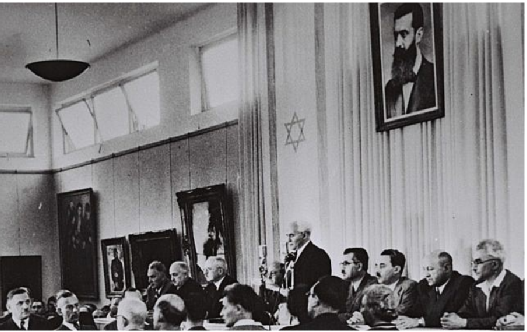
David Ben-Gurion, flanked by the members of his provisional government, reads the Declaration of Independence in the Tel Aviv Museum Hall on May 14, 1948
(Israel Government Press Office)
WHY ISRAEL’S FIRST LEADERS
CHOSE NOT TO CALL THE COUNTRY ‘PALESTINE’ IN ARABIC
National archive reveals a debate on the eve of independence over whether Arabic speakers should refer to the the new Jewish state as ‘Filastin,’ ‘Sayoun’ or ‘Eesra’il’
Times of Israel, Matti Freedman, 11 April 2013,
Days before the establishment of the State of Israel in May 1948, Zionist officials met to decide what the new country would be called in Arabic, a document released Thursday by the state archive
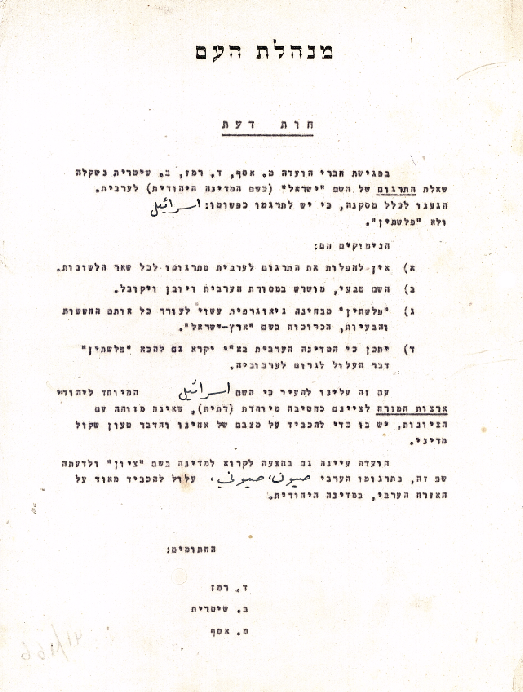
The document mentions three options:
Palestine, or Filastin; Zion, or Sayoun; and Israel, or Eesra’il.
The three officials — who included Bechor-Shalom Sheetrit, later a prominent Cabinet minister — were working under two assumptions: That an Arab state was about to be established alongside the Jewish one in keeping with the UN’s partition resolution the year before, and that the Jewish state would include a large Arab minority whose feelings needed to be taken into account.
They rejected the name Palestine, they wrote, because they thought that would be the name of the new Arab state.
“It is likely that the Arab state that will be established in the Land of Israel will also be called Palestine in the future, which could cause confusion,” the officials wrote.
They rejected the name Zion, or Sayoun, seemingly because the words “Zion” and “Zionist” already had a pejorative meaning in the Arab world. Calling the country Zion “would cause real difficultly for the Arab citizen in the Jewish state,” the document says.
In the end, they opted for the most straightforward option: Eesra’il, or Israel.
Although the United States supported the Balfour Declaration of 1917, which favored the establishment of a Jewish national home in Palestine, President Franklin D. Roosevelt had assured the Arabs in 1945 that the United States would not intervene without consulting both the Jews and the Arabs in that region. The British, who held a colonial mandate for Palestine until May 1948, opposed both the creation of a Jewish state and an Arab state in Palestine as well as unlimited immigration of Jewish refugees to the region. Great Britain wanted to preserve good relations with the Arabs to protect its vital political and economic interests in Palestine.
Soon after President Truman took office, he appointed several experts to study the Palestinian issue. In the summer of 1946, Truman established a special cabinet committee under the chairmanship of Dr. Henry F. Grady, an Assistant Secretary of State, who entered into negotiations with a parallel British committee to discuss the future of Palestine. In May 1946, Truman announced his approval of a recommendation to admit 100,000 displaced persons into Palestine and in October publicly declared his support for the creation of a Jewish state. Throughout 1947, the United Nations Special Commission on Palestine examined the Palestinian question and recommended the partition of Palestine into a Jewish and an Arab state. On November 29, 1947 the United Nations adopted Resolution 181 (also known as the Partition Resolution) that would divide Great Britain’s former Palestinian mandate into Jewish and Arab states in May 1948 when the British mandate was scheduled to end. Under the resolution, the area of religious significance surrounding Jerusalem would remain a corpus separatum under international control administered by the United Nations.
Although the United States backed Resolution 181, the U.S. Department of State recommended the creation of a United Nations trusteeship with limits on Jewish immigration and a division of Palestine into separate Jewish and Arab provinces but not states. The State Department, concerned about the possibility of an increasing Soviet role in the Arab world and the potential for restriction by Arab oil producing nations of oil supplies to the United States, advised against U.S. intervention on behalf of the Jews. Later, as the date for British departure from Palestine drew near, the Department of State grew concerned about the possibility of an all-out war in Palestine as Arab states threatened to attack almost as soon as the UN passed the partition resolution.
Despite growing conflict between Palestinian Arabs and Palestinian Jews and despite the Department of State’s endorsement of a trusteeship, Truman ultimately decided to recognize the state Israel.
1948 ARAB–ISRAELI WAR
Wikipedia (see also ‘The Map History of Modern Israel’)
The 1947–49 Palestine war[a], known in Hebrew as the War of Independence (Hebrew: מלחמת העצמאות, Milkhemet Ha'Atzma'ut) or the War of Liberation (Hebrew: מלחמת השחרור, Milkhemet HaShikhrur) and in Arabic as The Nakba or Catastrophe (Arabic: النكبة, al-Nakba), refers to the war that occurred in the former Mandatory Palestine during the period between the United Nations vote on the partition plan on November 30, 1947, and the official end of the first Arab–Israeli war on July 20, 1949.
Historians divide the war into two phases:
The 1947–48 Civil War in Mandatory Palestine (sometimes called an "intercommunal war")[19] in which the Jewish and Arab communities of Mandatory Palestine supported by the Arab Liberation Army, clashed while the region was still fully under British rule.
The 1948 Arab–Israeli War after 15 May 1948, marking the end of the British Mandate and the birth of Israel, in which Transjordan, Egypt, Syria and Iraq intervened in sending expeditionary forces that entered former British Palestine and engaged the Israeli forces.
At the end of the war, the State of Israel kept the area that had been recommended by the UN General Assembly Resolution 181 as well as almost 60% of the area allocated to the proposed Arab state,[20] including the Jaffa, Lydda and Ramle area, Galilee, some parts of the Negev, a wide strip along the Tel Aviv–Jerusalem road, and some territories abutting the area that would become the West Bank, putting them under military rule. Transjordan took control of most of the remainder of the Palestinian mandate, which it annexed and renamed the West Bank, while the Egyptian military took control of the Gaza Strip. With Jordan occupying the West Bank and Egypt occupying Gaza, no state was created for the Palestinian Arabs.
Dramatic demographic changes accompanied the war in the country. Around 700,000 Palestinian Arabs fled or were expelled out of 900,000 from the area that became Israel, and they became Palestinian refugees. Due to the war, around 10,000 Jews fled or were expelled from their homes in Palestine. In the three years following the war, about 700,000 Jews fled from Europe and Arab lands and immigrated to Israel, with one third of them having left or been expelled from their previous countries of residence in the Middle East. These Jewish refugees were absorbed into Israel in the One Million Plan
See also
Surviving Survival
What happened to
Holocaust camp survivors
who wanted
to come to Palestine?
UN PARTITION PLAN
Jewish United Fund 2011 (18.36)
NOVEMBER 29, 1947:
THE STORY OF A VOTE
ToldotYisrael 2010 (10.02)
|
United Nations Resolution 181 - Partition of Palestine into |
Episode 51 - Memories of Balfour and the British Mandate November 02, 2017
Shlomo Hillel immigrated to Mandatory Palestine following the Balfour Declaration and became a prominent politician and diplomat.
He took part in the creation of Israel

